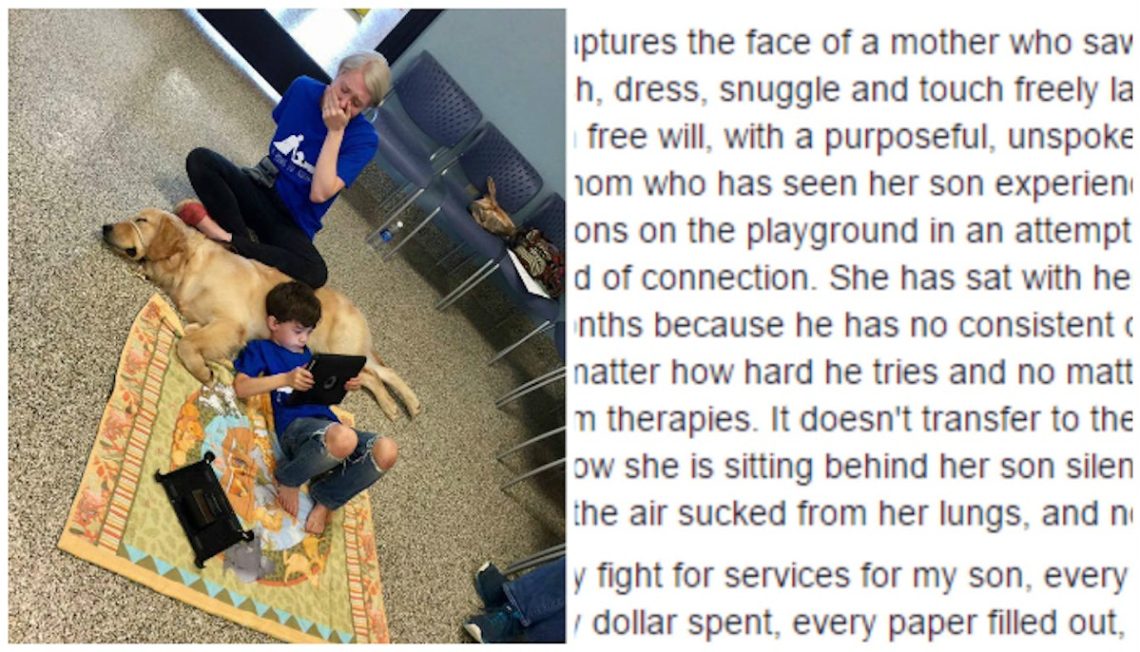
Service Dogs for Children with Autism: An Interview with a Mom
Service dogs for children with autism can change the lives of the children they help, as well as the lives of their entire family. They are trained to soothe their charges, keep them safe, and even help communicate with those around them. We spoke to Brandy, a mother who learned about service dogs for autistic children and decided to get one to help her son Xander.
Contents
- What training did your dog have before coming to your house?
- How did you get your service dog?
- Did you and your son go through any training before bringing a dog home?
- What does a dog do to help your son?
- What do you think people should know about service dogs for children with autism?
- What positive impact do service dogs have on the lives of children with autism?
What training did your dog have before coming to your house?
Our dog Lucy has been trained by the National Guide Dog Training Service (NEADS) Prison Pups program. Their dogs are trained in prisons across the country by prisoners who have committed non-violent crimes. On the weekends, volunteers called puppy caregivers pick up the dogs and help teach them social skills. The preparation of our dog Lucy lasted about a year before she ended up at our house. She is trained as a normal working dog, so she can open doors, turn on lights and fetch items, while also paying attention to the social and emotional needs of my eldest son Xander.
How did you get your service dog?
We applied in January 2013 after reviewing the information and realizing that this program was right for us. NEADS requires a very detailed application with medical records and recommendations from doctors, teachers, and family members. After NEADS approved us for a dog, we had to wait until a suitable one was found. They chose the right dog for Xander based on his preferences (he wanted a yellow dog) and his behavior. Xander is excitable, so we needed a calm breed.
Did you and your son go through any training before bringing a dog home?
After we were matched with Lucy, I was scheduled to take part in a two-week training session at the NEADS campus in Sterling, Massachusetts. The first week was full of classroom activities and dog handling lessons. I had to take a dog first aid course and learn all the commands Lucy knows. I practiced getting in and out of buildings, getting her in and out of the car, and I also had to learn how to keep the dog safe at all times.
Xander was with me the second week. I had to learn how to handle a dog in tandem with my son. We are a working team. I keep the dog on a leash on one side and Xander on the other. Wherever we go, I’m responsible for everyone, so I had to learn how to keep us all safe at all times.
What does a dog do to help your son?
First of all, Xander was a fugitive. That is, he could jump out and run away from us at any moment. I affectionately called him Houdini, as he could get out of my hand or run away from home at any moment. Since it’s not a problem now, I look back and smile, but before Lucy showed up, it was very scary. Now that he’s tied to Lucy, he can only go where I tell him to.
Secondly, Lucy calms him down. When he has an outburst of emotions, she tries to calm him down. Sometimes clinging to him, and sometimes just being there.
And finally, she helps Xander communicate with the outside world. Although he can be very loud and talkative, his socialization skills needed support. When we go out with Lucy, people show genuine interest in us. Xander has learned to tolerate questions and requests to pet his dog. He also answers questions and explains to people who Lucy is and how she helps him.
One day at the pediatric occupational therapy center, Xander was waiting for his turn. He ignored everyone around him, but there were a lot of people there that day. Many children constantly asked to pet his dog. And although he answered in the affirmative, his attention and eyes were focused exclusively on his tablet. While I was making his appointment, the man next to me was trying to convince his son to ask the boy if he could pet his dog. But the little boy said, “No, I can’t. What if he says no? And then Xander looked up and said, “I won’t say no.” He stood up, took the boy by the hand and led him to Lucy. He showed him how to pet her and explained that she was a fawn Labrador and that she was his special working dog. I was in tears. It was amazing and impossible before the appearance of Lucy.
I hope that in a year or two Xander will be able to handle Lucy on his own. Then she will be able to fully demonstrate her skills. She is trained to keep him safe, help him with his daily chores, and remain his companion even when he has difficulty making friends in the outside world. She will always be his best friend.
What do you think people should know about service dogs for children with autism?
First, I would like people to know that not every service dog is a guide dog for the blind. Likewise, not every person who has a service dog has a disability, and it is very impolite to ask why they have a service dog. It’s the same as asking someone what medicine they take or how much they earn. We often let Xander say that Lucy is his autistic service dog because it helps his communication skills. But that doesn’t mean we have to tell people about it.
And finally, I would like people to understand that although Xander most often allows people to pet Lucy, the choice is still his. He can say no, and I’ll help him out by putting a patch on Lucy’s vest asking him not to touch the dog. We don’t use it often, usually on days when Xander is not in the mood to socialize and we want to respect the social boundaries he is trying to develop and explore.
What positive impact do service dogs have on the lives of children with autism?
This is a wonderful question. I believe that Lucy really helped us. I can see with my own eyes that Xander has become more outgoing and I can be sure of his safety when Lucy is by his side.
But at the same time, therapy dogs for children with autism may not be suitable for every family where there is a child with an autism spectrum disorder. First, it’s like having another child. Not only because you need to take care of the needs of the dog, but also because now this dog will accompany you and your child almost everywhere. In addition, it will take a lot of money to get such an animal. At first, we did not even imagine how costly this undertaking would be. At that time, a service dog through NEADS was worth $9. We are very lucky to have received a lot of help from our community and local organizations, but the financial aspect of getting a dog for a child with autism must be taken into account.
Finally, as a mother of two wonderful children and the most beautiful dog, I would also like parents to prepare emotionally. The process is very stressful. You need to provide information about your family, your child’s health and your life situation, which you have not told anyone about before. You must note and label each problem your child has in order to be selected for a service dog. I was dumbfounded when I saw all this on paper. I really wasn’t ready to not only read all of this, but actively discuss it with relatively unfamiliar people.
And while these are all warnings and things I myself would like to know before applying for a service dog, I still wouldn’t change a thing. Lucy has been a blessing to me, both my boys and our entire family. The benefits really outweigh the extra work involved in having such a dog in our lives and we are truly grateful for it.





